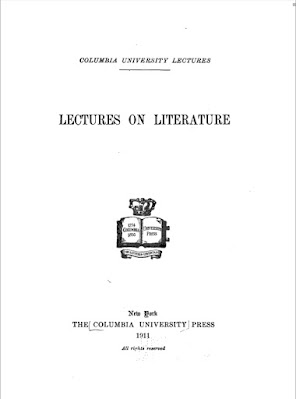Columbia
University Lectures: Lectures On Literature (1911)
These
lectures by members of the Faculty of Columbia University were delivered, with
one exception, during the academic year 1909-1910.
CONTENTS
INTRODUCTION LECTURE PAGE
I
APPROACHES
TO LITERATURE
By
Brander Matthews, Professor of Dramatic Literature
ORIENTAL
LITERATURES
II
SEMITIC
LITERATURES
By
Richard J H Gottheil, Professor of Rabbinical Literature and the Semitic
Languages
III
THE
LITERATURE OF INDIA AND
PERSIA
By
A V W Jackson, Professor of Indo-Iranian Languages
IV
CHINESE
LITERATURE
By
Friedrich Hirth, Professor of Chinese
CLASSICAL
LITERATURES
V
GREEK
LITERATURE
By
Edward Delavan Perry, Jay Professor of Greek
VI
LATIN
LITERATURE
By
Nelson Glenn McCrea, Professor of Latin
LITERARY
EPOCHS
VII
THE
MIDDLE AGES
By
William Witherle Lawrence, Associate Professor of English
VIII
THE
RENAISSANCE
By
Jefferson B Fletcher, Professor of Comparative Literature
IX
THE
CLASSICAL RULE
By
John Erskine, Associate Professor of English
X
THE
ROMANTIC
EMANCIPATION
By
Curtis Hidden Page, sometime Adjunct Professor of the Romance Languages and
Literatures
MODERN
LITERATURES
XI
ITALIAN
LITERATURE IN THE EIGHTEENTH
CENTURY
By
Carlo L Speranza, Professor of Italian
SPANISH
LITERATURE
By
Henry Alfred Todd, Professor of Romance Philology
XIII
ENGLISH
LITERATURE
By
Ashley H Thorndike, Professor of English
XIV
FRENCH
LITERATURE
By
Adolphe Cohn, Professor of the Romance Languages and Literatures
XV
GERMAN
LITERATURE
By
Calvin Thomas, Gerhard Professor of the Germanic Languages and
Literatures
XVI
RUSSIAN
LITERATURE
By J
A Joffe, Lecturer on Slavonic Literature
XVII
THE
COSMOPOLITAN
OUTLOOK
By
William P Trent, Professor of English Literature
CONCLUSION
XVIII
LITERARY CRITICISM
By J E Spingarn, Professor of Comparative Literature
INDEX
The PDF might take a minute to load. Or, click to download PDF.
If your Web browser is not configured to display PDF files.
No worries, just click here to download the PDF file.








